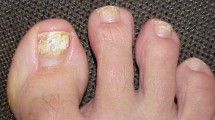Abstract
Mycological investigation of 108 nail specimens taken from a total of 41 patients examined over three years included direct microscopy and repeated cultures. A higher incidence of onychomycosis of the fingernails (75%) was observed in women while afflictions of the toenails (71%) prevailed in men. The highest prevalence of onychomycosis was found in patients between 50 and 70 years of age.Candida albicans was the dominant organism causing onychomycosis (prevalence rate 60.9%), followed byC. parapsilosis (19.6%),C. tropicalis (9.8),C. krusei (4.9),C. guilliermondii andC. zeylanoides (2.4% each).
Similar content being viewed by others
References
Abu-Elteen K.H.: Incidence and distribution ofCandida species isolated from human skin in Jordan.Mycoses42, 311–317 (1999).
Al-Sogair S.M., Moawad M.K., Al-Humaidan Y.M.: Fungal infections as a cause of skin disease in the eastern province of Saudi Arabia: prevailing fungi and pattern of infection.Mycoses34, 333–337 (1991).
Banerjee U., Sethi M., Pasricha J.S.: Study of onychomycosis in India.Mycoses33, 411–415 (1990).
Budak A., Macura A.B., Mazur T.: Fungal species isolated from skin and nail of hands and feet of patients suspected of mycotic infection.Mycoses30, 434–439 (1987).
Clayton Y.M.: Clinical and mycological diagnostic and aspects of onychomycosis and dermatomycoses.Clin. Exp. Dermatol.17, 37–40 (1992).
Daniel C.R., Elewski B.E.:Canadida as a nail pathogen in healthy patients.J. Miss. State Med. Assoc.36, 379–381 (1995).
de Ocariz M.M.S., Arenas R., Ranero-Juárez G.A., Farrera-Esponda F., Monroy-Ramos E.: Frequency of toenail onychomycosis in patients with cutaneous manifestations of chronic venous insufficiency.Internat. J. Dermatol.40, 18–25 (2001).
Dorko E., Kmeťová M., Pilipčinec E., Bračoková I., Dorko F., Danko J., Švický E., Tkáčiková L'.: Rare non-albicans Candida species detected in different clinical diagnoses.Folia Microbiol.45, 364–368 (200a).
Dorko E., Kmeťová M., Dorko F., Bračoková I., Danko J., Švický E., Tkáčiková L’.: Prevalence ofCryptococcus neoformans in clinical specimens.Folia Microbiol.45, 369–372 (2000b).
Faergemann J.: The role of yeasts in onychomycosis.Mycoses39, 223–224 (1996).
Gautret P., Rodier M.H., Kauffmann-Lacroix C., Jacquemin J.L.: Case report and review. Onychomycosis due toCandida parapsilosis.Mycoses43, 433–435 (2000).
Haneke E.: Fungal infections of the nails.Semin. Dermatol.10, 41–53 (1991).
Hay R.J., Baran R., Moore M.H., Wilkinson J.D.:Candida onychomycosis an evaluation of the role ofCandida species in nail disease.Brit. J. Dermatol.118, 47–58 (1988).
Hedderwick S., Kauffman C.A.: Opportunistic fungal infections: superficial and systemic candidiasis.Geriatrics52, 50–59 (1997).
Heikkilä H., Stubb S.: The prevalence of onychomycosis in Finland.Brit. J. Dermatol.133, 699–703 (1995).
Jain S., Sehgal V.N.: Onychomycosis: an epidemio-etiologic perspective.Internat. J. Dermatol.39, 100–103 (2000).
Jautová J., Virágová S., Ondrašovič M., Holoda E.: Incidence ofCandida species isolated from human skin and nails: a survey.Folia Microbiol.46, 333–337 (2001).
Kaszuba A., Seneczko F., Lipowczan G., Bienias L., Kostusiak M., Lupa S.: Fungal flora in human skin and skin appendages infections in the region of Łódź, Poland,Mycoses41, 249–253 (1998).
Kwok Y.K.C., Tay Y.K., Goh C.L., Kamarudin A., Koh M.T., Seow C.S.: Epidemiology andin vitro activity of antimycotics against candidal vaginal/skin/nail infections in Singapore.Internat. J. Dermatol.37, 145–149 (1998).
Lazúrová I.: Diabetes mellitus and endocrinopathies (In Slovak)Cartridge4, 49–71 (2000a).
Lazúrová I., Schroner Z., Trejbal D.: Diabetes mellitus and thyreopathies (In Slovak)Slov. Lekár7–8, 283–285 (2000b).
Midgley G.M., Moore M.K.: Mycology of nail disorders.J. Am. Acad. Dermatol.31, 68–74 (1994).
Ng K.P., Madasamy M., Saw T.L., Baki A., He J., Soo-Hoo T.S.:Candida biotypes isolated from clinical specimens in Malaysia.Mycopathologia144, 135–140 (1999).
Roberts D.T.: Prevalence of dermatophyte onychomycosis in the United Kingdom: result of an omnibus survey.Brit. J. Dermatol.126, 23–27 (1992).
Seebacher C.:Candida in der Dermatologie.Mycoses42, 63–67 (1999).
Segal R., Kimichi A., Kritzman A., Inbar R., Segal Z.: The frequency ofCandida parapsilosis in onychomycosis. An epidemiological survey in Israel.Mycoses43, 349–353 (2000).
Summerbell R.C., Kane J., Kradjden S.:Onychomycosis, tinea pedis and tinea manuum caused by non-dermatophytic filamentous fungi.Mycoses32, 609–619 (1989).
Vélez A., Linares M.J., Fenández-Roldán J.C., Casal M.: Study of onychomycosis in Córdoba, Spain: prevailing fungi and pattern of infection.Mycopathologia137, 1–8 (1997).
Willemsen M.: Changing pattems in superficial infections: focus on onychomycosis.J. Eur. Acad. Dermatol. Venerol.2, 6–11 (1993).
Williams H.C.: The epidemiology ofonychomycosis in Britain.Brit. J. Dermatol.129, 101–109 (1993).
Author information
Authors and Affiliations
Rights and permissions
About this article
Cite this article
Dorko, E., Jautová, J., Tkáčiková, L. et al. The frequency ofCandida species in onychomycosis. Folia Microbiol 47, 727–731 (2002). https://doi.org/10.1007/BF02818679
Received:
Revised:
Issue Date:
DOI: https://doi.org/10.1007/BF02818679




